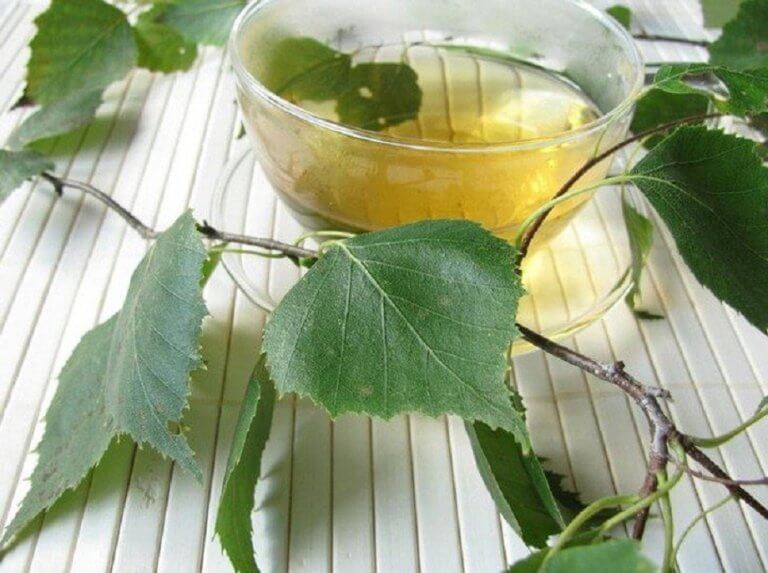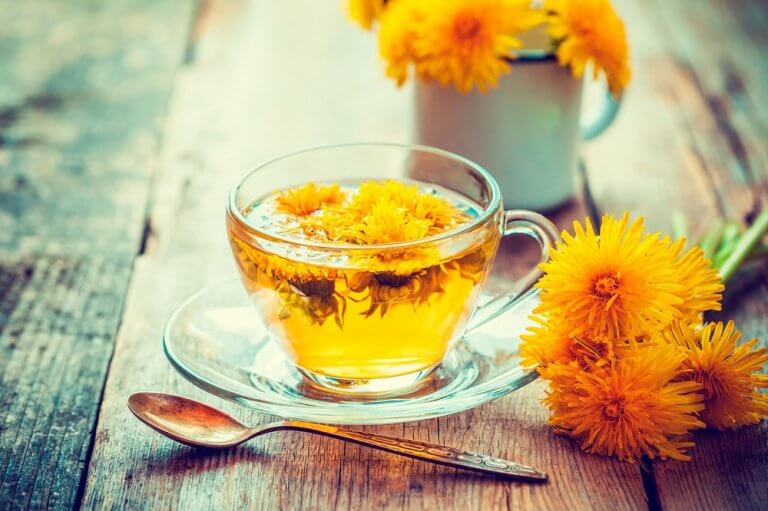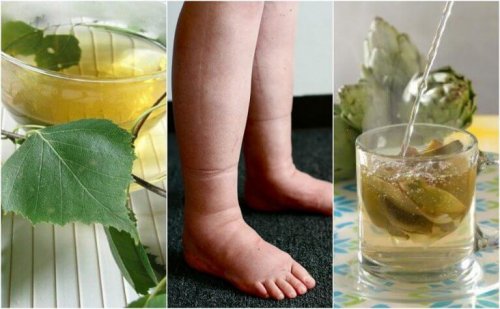식물성 이뇨 차의 소염 성분은 체액을 제거하는 역할을 하므로 체액 저류 증상 완화에 도움이 된다. 다양한 신체 조직에 체액이 축적되는 체액 저류는 고혈압, 순환 장애 및 기타 일반적인 질병과 관련이 있다. 특히 과도한 설탕 섭취, 림프계 문제, 혹은 신장 기능에 방해가 되는 다양한 요인 때문일 수 있다.
대개 체액 저류는 심각한 질환은 아니지만 제대로 대처하지 않으면 더 큰 관리를 요하는 질병으로 이어질 수도 있다. 오늘 소개하는 이뇨 차는 만들기도 쉽고 일반적인 치료법과는 달리 독하거나 부작용을 일으키지도 않는다.
체액 저류 증상 완화를 위해 시도해 볼 만한 5가지 이뇨 차를 알아보자.
체액 저류를 완화하는 5가지 이뇨 차
1. 자작나무 차

자작나무 잎은 소변 생성을 촉진하여 체액 및 몸에 쌓인 노폐물을 제거한다. 해독을 촉진하면서 나트륨 수치 균형 유지를 돕는 소브산칼륨이 다량으로 함유되어 있다.
재료
- 말린 자작나무 잎 1티스푼(5g)
- 물 1컵(250mL)
만드는 방법
- 끓는 물에 자작나무 잎을 넣은 다음 10분간 둔다.
- 걸러서 마신다.
마시는 방법
- 오전 중간에 한 컵, 오후에 한 컵을 마신다.
- 최소 3주간 계속 마신다.
주의: 임산부 그리고 고혈압 혹은 심장 질환이 있는 사람은 마시면 안 된다.
더 읽어보기: 이뇨 효과가 있는 5가지 스무디로 체액 저류 치료하기
2. 버드나무 껍질 차
버드나무 껍질의 이뇨 성분은 수종 및 관련 질병을 완화하는 데 이상적이다. 소변으로 독소를 제거하는 데 도움이 되는 필수 지방, 항산화제, 비타민, 무기질이 함유되어 있기 때문이다.
재료
- 버드나무 껍질 1티스푼(5g)
- 물 1컵(250mL)
만드는 방법
- 끓는 물에 버드나무 껍질을 넣고 뚜껑을 덮는다.
- 10분간 두었다가 거른다.
마시는 방법
- 2주 연속으로 오전 중간에 이 차를 마신다.
주의: 아스피린 알레르기가 있거나, 호흡기 알레르기 또는 위궤양이 있다면 피해야 한다.
3. 녹차

녹차는 몸에 좋은 다양한 효능 덕분에 자연 약재료 사용된다. 함께 결합하면 소변 생성 및 해독을 촉진하는 항산화와 소염 성분이 다량으로 함유되어 있다.
재료
- 녹차 1티스푼(5g)
- 물 1컵(250mL)
만드는 방법
- 끓는 물에 녹차를 넣고 10분간 둔다.
- 차가 우러나면 거른다.
마시는 방법
- 3주 연속으로 아침에 일어나자마자 공복에 이 차를 한 컵 마신다.
주의: 녹차는 임신 및 수유 중인 여성, 고혈압이나 신경 질환이 있는 사람은 피해야 한다.
4. 아티초크 차
몸에 저류된 체액을 제거하는 가장 좋은 치료제는 바로 아티초크 차다. 간 기능을 개선하고 신장을 정화하며 염증 관련 질병을 완화한다.
재료
- 아티초크 1/2개
- 물 1컵(250mL)
만드는 방법
- 아티초크 1/2개의 잎을 물과 함께 끓인다.
- 불을 줄이고 2~3분간 둔다.
- 불을 끄고 식혀서 거른다.
마시는 방법
- 아침에 일어나자마자 공복에 마시고, 원한다면 오후에 한 번 더 마신다.
- 2~3주 연속으로 마신다.
주의: 옥살산염 성분 때문에 담석이 있는 사람들에게는 권하지 않는다.
더 읽어보기: 아티초크수의 효능과 만드는 방법
5. 민들레 차

천연 약재 중에서 민들레는 가장 강력한 이뇨제로 체액 제거를 촉진하고 혈액 정화를 돕는다.
재료
- 민들레 1티스푼(10g)
- 물 1컵(250mL)
만드는 방법
- 끓는 물에 민들레를 넣고 뚜껑을 덮는다.
- 5~10분간 뒀다가 거른다.
마시는 방법
- 오전 중간에 한 컵을 마신다.
- 2주간 매일 반복한다.
주의: 임신 중이거나 담석, 혹은 위장 질환이 있는 경우 피한다.
사지가 무겁고 체액이 제대로 배출되지 않는 체액 저류 증상을 경험한다면 위의 건강 차를 마셔보자.
참고 문헌
모든 인용된 출처는 품질, 신뢰성, 관련성 및 유효성을 보장하기 위해 저희 팀이 철저히 검토했습니다. 이 글의 참고 문헌은 신뢰할 수 있으며 학문적 또는 과학적 정확성을 갖춘 것으로 간주되었습니다.
- Ajmera, P., Kalani, S., & Sharma, L. (2019). Parsley-benefits & side effects on health. International Journal of Physiology, Nutrition and Physical Education, 4(1), 1236-1242. https://www.journalofsports.com/archives/2019/vol4/issue1/4-1-308
- Atto, V., Oussou, N. J. B., Diby, Y. B., Konan, B. A., & Datte, J. Y. (2023). Diuretic activity assessment of an aqueous extract of Hibiscus sabdariffa (Malvaceae) leaves on Wistar rats. Journal of Drug Delivery & Therapeutics, 13(11), 56-61. https://jddtonline.info/index.php/jddt/article/view/5999
- Bekheet, S., & Sota, V. (2019). Biodiversity and medicinal uses of globe artichoke (Cynara scolymus L.) plant. Journal of Biodiversity Conservation and Bioresource Management, 5(1), 39-54. https://www.banglajol.info/index.php/jbcbm/article/view/42184
- Carneiro, D. M., Freire, R. C., Honório, T. C., Zoghaib, I., Cardoso, F. F., Tresvenzol, L. M., de Paula, J. R., Sousa, A. L., Jardim, P. C., & da Cunha, L. C. (2014). Randomized, Double-Blind Clinical Trial to Assess the Acute Diuretic Effect of Equisetum arvense (Field Horsetail) in Healthy Volunteers. Evidence-Based Complementary and Alternative Medicine, 2014, 1-8. https://onlinelibrary.wiley.com/doi/10.1155/2014/760683
- Chakraborty, M., Kamath, J. V., & Bhattacharjee, A. Potential Interaction of Green Tea Extract with Hydrochlorothiazide on Diuretic Activity in Rats (2014). International Scholarly Research Notices, 2014(4), 1-5. https://www.ncbi.nlm.nih.gov/pmc/articles/PMC4897558/
- Di Napoli, A., & Zucchetti, P. (2021). A comprehensive review of the benefits of Taraxacum officinale on human health. Bulletin of the National Research Centre, 45(110), 1-5. https://link.springer.com/article/10.1186/s42269-021-00567-1
- Divya, D. (2022). Effect of Fennel seed: On women health. International Journal of Advances in Nursing Management, 10(2), 95-98. https://www.indianjournals.com/ijor.aspx?target=ijor:ijanm&volume=10&issue=2&article=002
- Halder, S., & Sharma, A. (2017). A review on Urtica dioica L.World Journal of Pharmacy and Pharmaceutical Sciences, 6, 404-421. https://www.wjpps.com/Wjpps_controller/abstract_id/7880
- Hedaoo, S. A., & Bodhankar, M. M. (2018). Advantages of natural diuretics over synthetic diuretics as a part of treatment. World Journal of Pharmacy and Pharmaceutical Sciences, 8(8), 310-327. https://www.wjpps.com/Wjpps_controller/abstract_id/10214
- Kubica, P., Szopa, A., Dominiak, J., Luczkiewicz, M., & Ekiert, H. (2020). Verbena officinalis (Common Vervain) – A Review on the Investigations of This Medicinally Important Plant Species. Planta Medica, 86(17), 1241-1257. https://www.thieme-connect.de/products/ejournals/html/10.1055/a-1232-5758
- Miraj, S., & Kiani, S. (2016). A review study of therapeutic effects of Salvia officinalis L. Der Pharmacia Lettre, 8(6), 299-303. https://core.ac.uk/reader/143840610
- Montagna, C. (s.f.). Soluciona la retención de líquidos. Blog Impulso Vital. Fundación Española del Corazón. https://fundaciondelcorazon.com/blog-impulso-vital/2649-soluciona-la-retencion-de-liquidos.html
- Patil, K., Sanjay, C. J., DoggALLI, N., Devi, K. R., & Harshitha, N. (2022). A Review of Calendula Officinalis Magic in Science. Journal of Clinical and Diagnostic Research, 16(2), ZE23-ZE27. https://www.jcdr.net/article_abstract.asp?id=16024
- Rastogi, S., Pandey, M. M., & Kumar Singh Rawat, A. (2015). Medicinal plants of the genus Betula–traditional uses and a phytochemical-pharmacological review. Journal of Ethnopharmacology, 159, 62-83. https://www.ncbi.nlm.nih.gov/pmc/articles/PMC7126499/
- Rather, M. A., Dar, B. A., Sofi, S. N., Bhat, B. A., & Qurishi, M. A. (2016). Foeniculum vulgare: A comprehensive review of its traditional use, phytochemistry, pharmacology, and safety. Arabian Journal of Chemistry, 9, S1574-S1583. https://www.sciencedirect.com/science/article/pii/S1878535212000792
- Sarfaraz, S., Sarwar, G., Fatima, W., Ramzan, S., Amjad, R., Tareen, R., & Irfan, S. (2015). Evaluation of diuretic potential of lemon juice and reconstituted lemon drink. World Journal of Pharmaceutical Research, 4(7), 254-259. https://www.semanticscholar.org/paper/EVALUATION-OF-DIURETIC-POTENTIAL-OF-LEMON-JUICE-AND-Sarfaraz-Sarwar/9447954bc566802222b32f7309321bfb8cc7b91f
- Tesfaye, A., & Mengesha, W. (2015). Traditional uses, phytochemistry and pharmacological properties of garlic (Allium Sativum) and its biological active compounds. International Journal of Scientific Research in Science, Engineering and Technology, 1, 142-148. https://www.researchgate.net/publication/298327340_Traditional_Uses_Phytochemistry_and_Pharmacological_Properties_of_Garlic_Allium_Sativum_and_its_Biological_Active_Compounds
- Thompson, A. D., & Shea, M. J. (Octubre de 2023). Hinchazón (edema). Manual MSD. https://www.msdmanuals.com/es-ar/hogar/trastornos-del-coraz%C3%B3n-y-los-vasos-sangu%C3%ADneos/s%C3%ADntomas-de-los-trastornos-cardiovasculares/hinchaz%C3%B3n
- Thuraisingam, S., Sunilson, J. A. J., Kumari, A. V. A. G., & Anandarajagopal, K. (2019). Preliminary phytochemical analysis and diuretic activity of the extracts of Coriandrum sativum leaves in Wistar albino rats. International Research Journal of Pharmacy and Medical Sciences, 3, 1-3. https://www.researchgate.net/publication/344283216_Preliminary_Phytochemical_Analysis_and_Diuretic_Activity_of_the_Extracts_of_Coriandrum_Sativum_Leaves_in_Wistar_Albino_Rats
